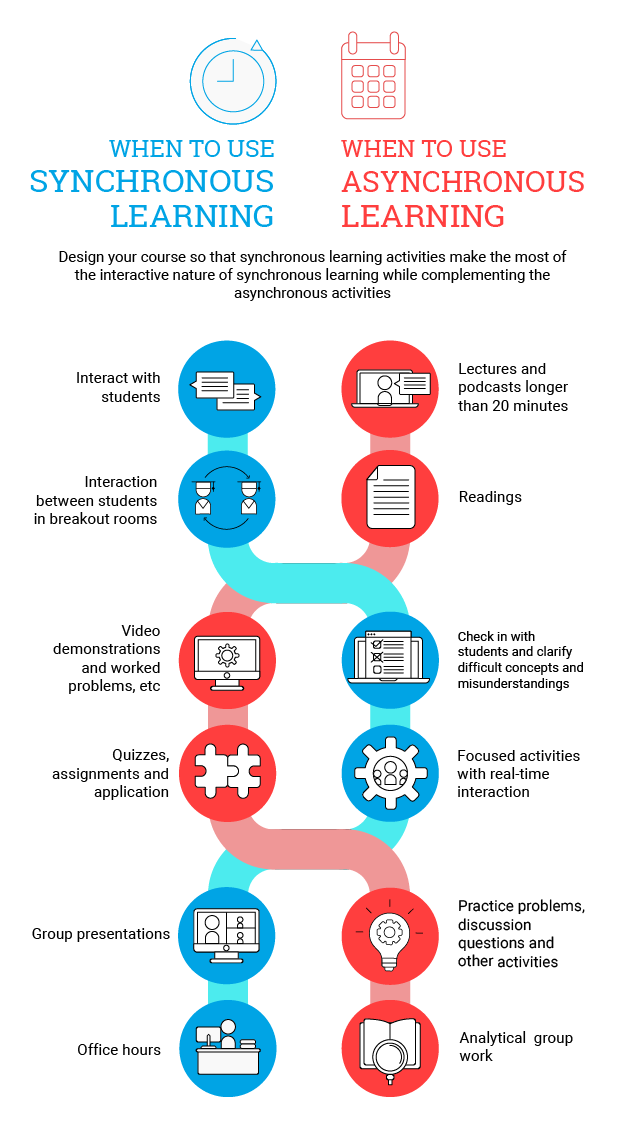Teaching Asynchronously
What is Asynchronous Learning?
- Comparison of online learning formats summary: Digital Learning Formats – Characteristics and Components PDF and Delivery Formats – PDF
- Nutshell: An asynchronous course has no required live online interactions and scheduled contact time between instructor and students.
- Students participate and communicate in the course without having to be online at the same time. However the instructor is very much present, engaging in very frequent (couple of times a week) communications with students, sharing video and email updates and facilitating the learning experiences.
- Teaching and learning activities occur in digital formats using a variety of learning technologies and digital resources.
- Course is characterized by regular and substantive online interactions between the course instructor and students.
- Defined expectations and deadlines for completion of assignments and other course related activities.
- Students may have to intermittently work in groups with other students or undertake collaborative activities, but these can be done asynchronously.
Mid-terms, tests, and quizzes including any final exams will take place digitally via a variety of formats. If a final exam is scheduled for the course, the exam will take place digitally on a certain day/time according to the institutional exam schedule. - Optional live, online office hours and/or group times as part of the course.
Resources
- An Affinity for Asynchronous Learning | Hybrid Pedagogy Article from Maha Bali
- Written in 2014, this is still a seminal aricle about equity and access associated with asynchronous learning.
- Synchronous and Asynchronous Learning: Two Basic Formats of Learning in an Online Environment | Centre for Teaching and Learning, Concordia University
- Excellent website outlining the differences between the two formats for teaching and learning with easy to follow charts
- Asynchronous Learning Across Time Zones | Center for Teaching and Learning, Columbia University in the City of New York
- Webpage highlighting strategies for engaging learners across time zones with asynchronous learning from “Communication and Community” to “Accessible Content”
- (The Right) Learning Modalities to Delivery Digital Learning: Part 3 (Asynchronous) | Article by Patti Shank, eLearning Industry
- good article highlighting the common content and social interactions, achieving more flexibility and deeper learning, and when we should use asynchronous
- Blended and Online Learning | Website from Taylor Institute for Teaching and Learning, University of Calgary
- This is an excellent site with many resources for online and blended learning courses.
- Interacting Asynchronously | Center for Teaching, Vanderbilt University
- This webpage, by Stacey M Johnson, Assistant Director for Educational Technology, shares ideas for engagement and interactions in asynchronous courses. She includes examples of “student-to -content” interactions, student-to-instructor interactions, student-to-student interactions and student-to-self.
- Fostering Fun: Engaging Students with Asynchronous Online Learning | Faculty Focus Article
- Lisa Forbes, an Assistant Clinical Professor in counseling program at University of Colorado provides some first-hand examples of how she has engaged students in her asynchronous classes.
- Low Bandwidth or Limited Connectivity: Creating a More Accessible Course for Learners | NIC PDF
- Inspired by Daniel Stanford’s article, Videoconferencing Alternatives: How Low-Bandwidth Teaching Will Save Us All, the NIC created-handout presents ideas and suggestions for creating more accessible courses that will work when students have low bandwidth and limited connectivity.
From Concordia University, this chart of when to use synchronous vs. asynchronous learning.
Synchronous and Asynchronous Learning by Centre for Teaching and Learning, Concordia University CC BY-SA 4.0

